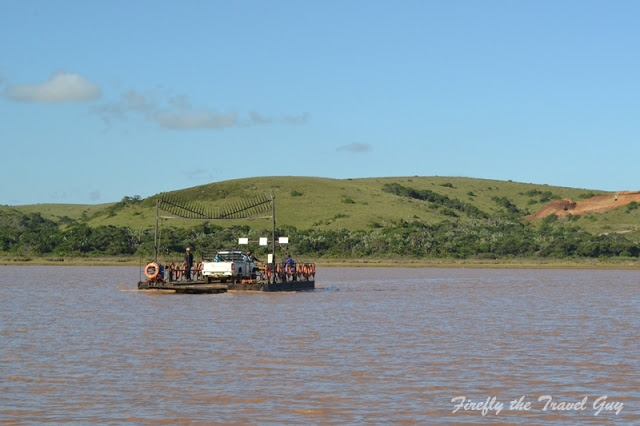
It doesn’t matter how big (or small) a town is, you are very likely to find a historic Dutch Reformed Church and a war memorial somewhere in it. Tarkastad in the Eastern Cape is no different. Tarkastad isn’t very big. In fact, most people I mention it to have never been there. Some haven’t even heard of it. I got to visit it for the first time when my son started his first job in the town at the beginning of 2025. As we drove into town I did a detour to have a look at the church, but the war memorial had to wait for the next morning.

The Tarkastad War Memorial stands in the middle of the intersection of two of the main roads in town and is quite an impressive monument. It was erected after the First World War and has three plaques with the names of men from the district who lost their lives during the war. After World War II a plaque was added with the names of the men who died in that war.

The main inscription on the memorial says the following:
1914 – 1918
THEY WHOM THIS MEMORIAL
COMMEMORATES WERE NUMBERED
AMONG THOSE WHO AT THE CALL
OF KING AND COUNTRY LEFT ALL
THAT WAS DEAR TO THEM, ENDURED
HARDNESS, FACED DANGERS AND
FINALLY PASSED OUT OF THE
SIGHT OF MEN BY THE PATH OF
DUTY AND SELF SACRIFICE, GIVING
UP THEIR LIVES THAT OTHERS
MIGHT LIVE IN FREEDOM.
LET THOSE WHO COME AFTER SEE TO IT
THAT THEIR NAMES BE NOT FORGOTTEN
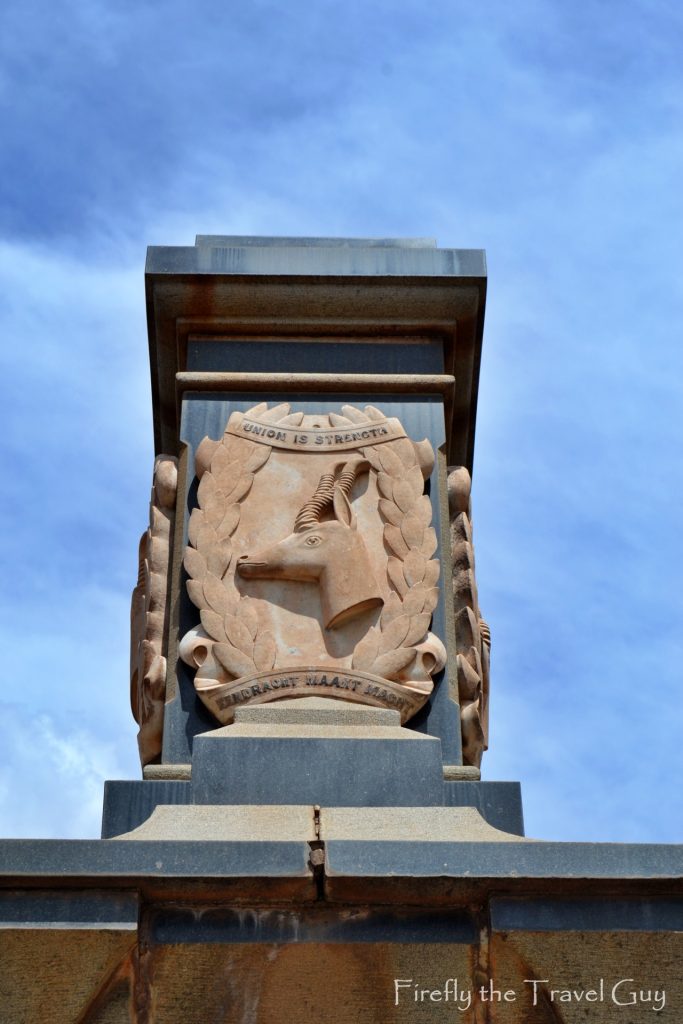
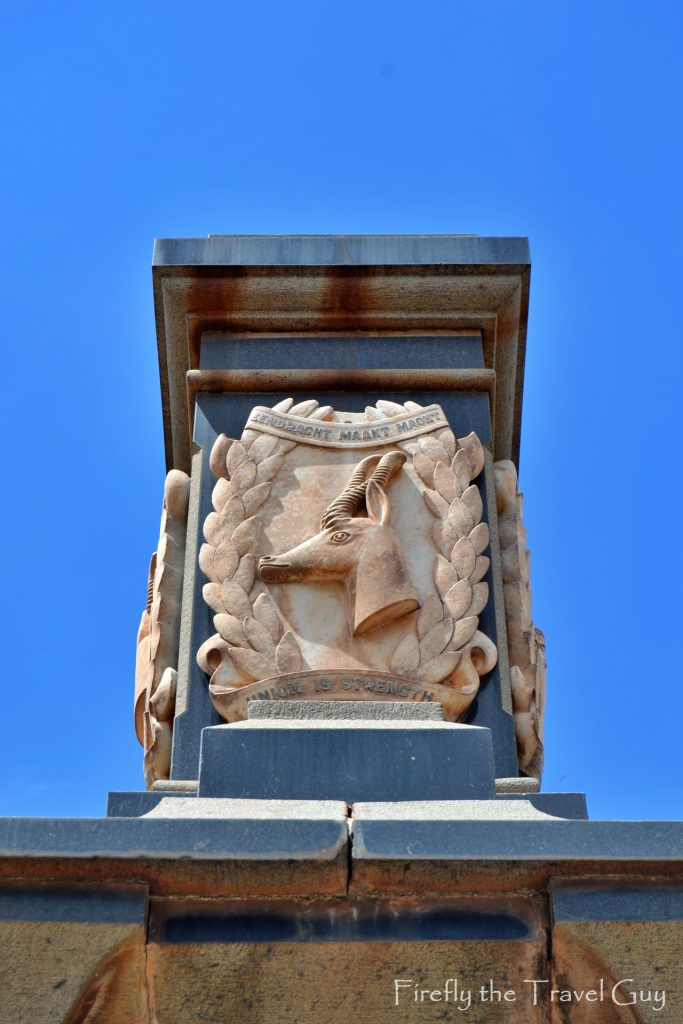
At the top of the memorial is a Springbok head with the words “Union is strength” and “Eendracht maakt macht” that used to be South Africa’s national motto.
Ex unitate vires (lit. “from unity, strength”) is a Latin phrase formerly used as the national motto of South Africa. It was originally translated as “Union is Strength” but was later revised in 1961 to mean “Unity is Strength”. Its Dutch version is “Eendracht maakt macht”, itself a non-literal translation of “in concordia res parvae crescunt”, originally the motto of the Dutch Republic. That translation, along with its French counterpart – “L’union fait la force” – is also the current motto of Belgium. It was adopted as the national motto of South Africa in 1910 when the Union of South Africa was formed but was replaced in 2000.
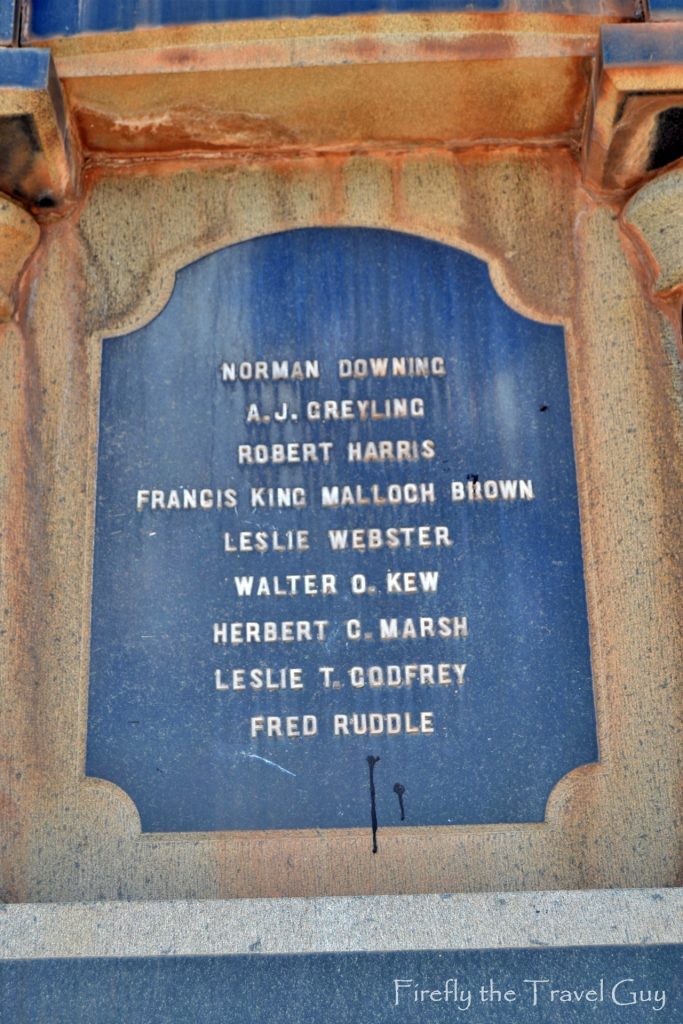
Being the history buff he is (he’s a history teacher after all), it didn’t take long for my son to research the names on the monument and I asked him if I could post his results here.
- Norman Oscar Downing was born in Tarkastad. He became a Sergeant in the C Squadron of the 8th Mounted Rifles (Midlandse Ruiters). He was killed in action at the age of 21 on 18 January 1915 at the Battle of Lutzputs, a conflict, during the Maritz Rebellion, during which government forces engaged rebel forces at Lutzputs, Nous, and Upington. The rebel force was captured, with the exception of Maritz. He is buried in Tarkastad Cemetery.
- Abraham Johannes Greyling was born in Tarkastad. He became a Private of the Natal Light Horse Regiment. He was killed in action at the age of 30 on 27 April 1915 at the Battle of Gibeon. he is buried in Gibeon Station Cemetery in Namibia.
- Robert Sykes Harris was born in Tarkastad on 12 August 1887. He became a Trooper of the 5th Mounted Rifles (Imperial Light Horse). He was killed in action at the age of 27 on 27 April 1915 at the Battle of Gibeon. He is buried in Gibeon Cemetery in Namibia, and has a commemoration stone in Tarkastad Cemetery.
- Francis King Malloch Brown was born in Grahamstown. He became a farmer before the war. He became a Trooper of the 4th South African Horse Regiment. He died of enteric fever at the age of 22 on 31 May 1916. He is buried in Voi Cemetery in Kenya
- Leslie Garnett Webster was born in Spring Valley, Tarkastad. He became a Private in A Company of the 4th South African Infantry Regiment. He was killed in action on 15 July 1916 at the age of 29 at the Battle of Delville Wood. His name is engraved into the Thiepval Memorial in France.
- Walter Oswald Kew was born in Tarkastad. He became a Private of C Company of the 3rd South African Infantry Regiment. He died of wounds received at the Battle of Delville Wood on 30 July 1916. He is buried at La Neuville British Cemetery, Corbie in France.
- Herbert Charles Marsh was born in East London. He became a Private of C Company of the 3rd South African Infantry Regiment. He was killed in action at Delville Wood at the age of 22 on 18 July 1916. He is buried at Dive Copse British Cemetery, Sailly-Le-Sac in France.
- Leslie Thomas Godfrey was born in Tarkastad. He became a Private of the Australian Infantry. He was killed in action in France on 25 July 1916. He is buried in London Cemetery and Extension, Longueval in France.
- Frederick Ruddle was born in Tarkastad. He became a Private of C Company of the 3rd South African Infantry Regiment. He was killed in action at the age of 21 on 17 July 1916 at Delville Wood. His name is engraved into the Thiepval Memorial in France.
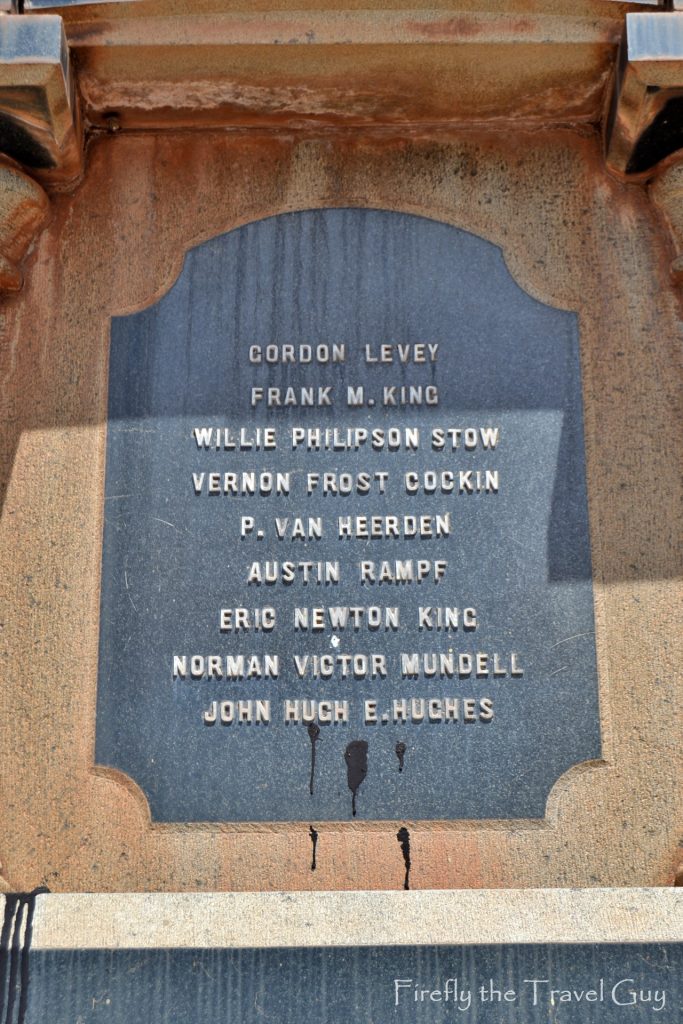
- Herbert Gordon Levey was born on 27 May 1899 in Fairview. He became a farmer in Tarkastad before joining D Company of the 2nd South African Infantry Regiment as a Private. he died of wounds at the age of 18 on 30 April 1918. He was awarded a Military Medal on 13 September 1918. he is buried in Esquelbecq Military Cemetery in France.
- Frank Maxfield King was born in Grahamstown on 12 September 1878. He became a Major of the 9th Battalion of the Loyal North Lancashire Regiment of the King’s Royal Rifle Corps. He was killed in action on 22 March 1918. His name is engraved on the Arras Memorial in France.
- William “Willie” Philipson Stow was born in Southern Rhodesia before moving to Tarkastad. He became a Private of B Company of the 1st South African Infantry Brigade. he died of wounds at the age of 23 on 10 October 1918. He is buried in Tincourt New British Cemetery in France.
- Vernon Frost Cockin was born in Waverly, before moving to Tarkastad. He was a Private of A Company of the 2nd South African Infantry Regiment. He was killed in action on 20 October 1916 at the age of 25. He is buried in Warlencourt British Cemetery.
- Pieter van Heerden was born in Tarkastad. He became a Private of the 2nd South African Infantry Regiment. He was killed in action at the age of 28 on 12 October 1916 when the 2nd and 4th South African Infantry attacked Snag and Tail Trenches. The assault died away, because of machine guns nests, placed well back in prepared positions, which caught the attacking waves at long range. His name is engraved on the Thiepval Memorial in France.
- Austin Rampf was born in Tarkastad, and maried Alice Carr. He was a Second Lieutenant of the South African Infantry Regiment. He was killed in action on 12 October 1916 when the 2nd and 4th South African Infantry attacked Snag and Tail Trenches. The assault died away, because of machine guns nests, placed well back in prepared positions, which caught the attaching waves at long range. His name is engraved on the Thiepval Memorial in France.
- Eric Newton King was born in Tarkastad, and educated at Kingswood College. He joined the 4th South African Infantry Regiment as a Private. He first experienced combat in German South West Africa, before being moved Europe. He died from wounds received, on 10 December, at the age of 20 on 15 December 1916. He is buried in St. Hilaire Cemetery in France.
- Norman Victor Mundell was born in Maclear. he became a Private of the 2nd South African Infantry Regiment. He was killed in action at the age of 19 on 12 April 1917 in the improvised and disastrous attack of the 9th (Scottish) Division on the German positions in the East of Fampoux. The 2nd SAI, who went in 400 strong, lost 16 officers and 285 men. He is buried in Brown’s Copse Cemetery in France.
- John Hugh Edward Hughes was born in Cradock. he became a Second Lieutenant of the 156th Siege Battalion of the Royal Garrison Artillery. He was killed in action on 10 July 1917 at the age of 25. He is buried in Cojeul British Cemetery, St. Martin-Sur-Cojeul in France.
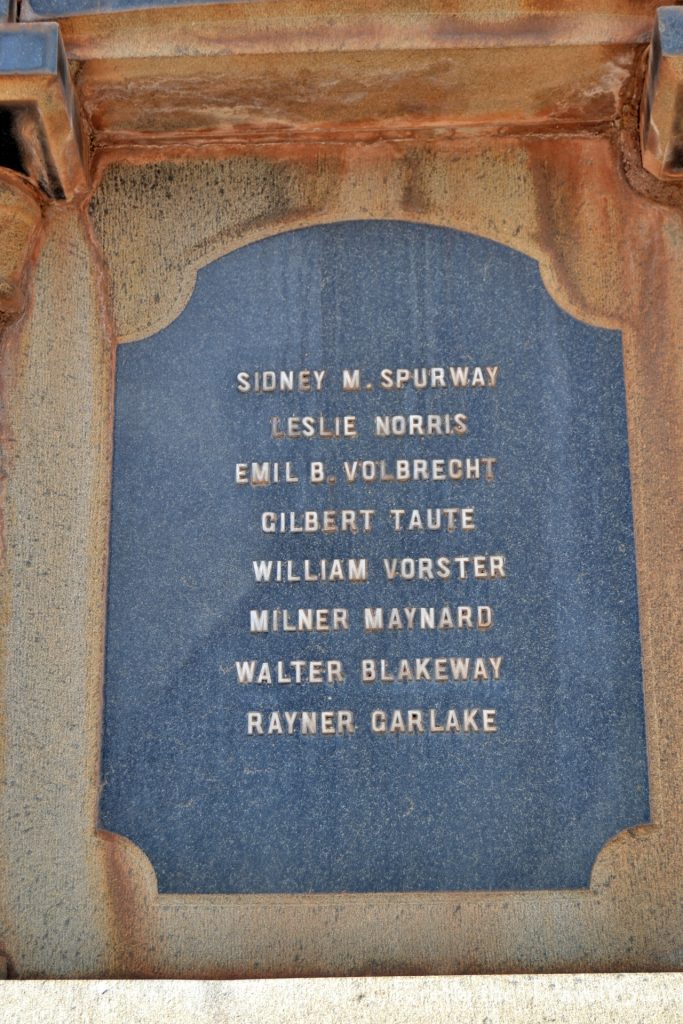
- Sidney MacDonald Spurway was born in Tarkastad. He became a Second Lieutenant and pilot in the 22nd Squadron of the Royal Flying Corps. He was killed in action on 21 September 1917. He is buried in Potijze Chateau Lawn Cemetery in Belgium.
- Leslie Norris was born in Sterkstroom. He became a Corporal of the 2nd South African Infantry Regiment. He was killed in action at the Third Battle of Ypres (Battle of Menin Road) at the age of 26 on 20 September 1917. His name is engraved on the Ypres (Menin Gate) Memorial.
- Emil Bawden Volbrecht was born in East London, before moving to Tarkastad. He became a Private of A Company of the 1st South African Infantry Regiment. The South African Military Archive in Irene has a very thin file for Private Volbrecht – not especially surprisng since he was dead a mere seven months after being taken on strength in Potchefstroom on 16 Feb. 1917. His attestation papers tell that he was 5ft. 10 inches (1,78 metres) tall, weighed 142lbs (64,5kg). They list his occupation as “Draper” and his religion as “Wesleyan”. From Potchefstroom he embarked at Cape Town on His Majesty’s Transport(HMT) Galway Castle on 10 March 1917 for England and was posted to Woking in Surrey for training. He was granted leave from 03 to 06 June and being only 75 minutes from London it is likely Emil would have spent his leave there with his pals. It is recorded that he joined the ‘battalion in the Field’ on 03 July and was posted to ‘B’ Company. Later, he transferred to ‘A’ Company. Private Volbrecht’s service file is ‘silent’ on his time with the battalion: the next entry is the record of his death. In view of this approximate three-month gap in his military service file we are fortunate that Peter Digby in Pyramids and Poppies dedicates an entire chapter to this period in the Brigade’s history, under the heading “The three bob-a-day men”. The Volbrechts, of course, would have had some knowledge of this period from letters sent home and from their son’s Diary. On the day that Private Volbrecht was posted the S A Brigade was at rest in Divisional reserve outside Arras at a place called Y Huts. However, to refer to the unit as a Brigade was a misnomer. Following the Battle of Arras and what Digby refers to as the Fampoux fiasco, the Brigade was a shadow of its former self and had been broken up into composite Battalions. Private Volbrecht was one of the 1 448 men sent from the Brigade Depot between April and the end of June, to bring the various units up to strength. Four days after his posting, on 07 July, the Brigade moved to a new training area between Simencourt and Berneville in the Somme district. This new posting, it is recorded, offered far more pleasant conditions than those experienced at Y Huts. He was killed in action at the Third Battle of Ypres (Battle of Menin Road) on 20 September 1917 at the age of 19. He is buried in Perth Cemetery in Belgium. Private Volbrecht was buried in the field and whilst his personal possessions would have been returned to the Volbrechts (Emil’s diary for instance) the family must have agonized over what had happened to their son during his final moments. Certainly they would have been anxious to know that he had not suffered. Emil’s remains were only recovered from the field two years later, in September 1919. During this time – and afterwards as well of course – Emil’s family would have been desperate to speak with someone ’on the spot’ at the time of his death – perhaps even witness to it.
- Gilbert Taute was born on 2 July 1898 in Klip Kraal, Tarkastad. He first joined the 5914 3rd SAMR as a Private, before joining the 2nd South African Infantry Regiment. He died of pneumonia at the age of 20 on 25 October 1918. He is buried in Broodwood Military Cemetery.
- Milner Milford Maynard became a Private of the 1st South African Infantry Regiment. He was killed in action on 30 April 1918. His name is engraved on the Ypres (Menin Gate) Memorial in Belgium.
- Walter Lennox Blakeway was born in East London. He became a Sergeant of the 2nd South African Infantry Regiment. It is recorded that he was one of the 3 officers and men who were relieved at Delville Wood on 20 July 1916. He was attatched to the 2nd Mortar Battery and later being wounded on 16 December 1916. He was killed in action on 12 April 1917 in the improvised and disastrous attack of the 9th Scottish Division on the German position in the East of Fampoux. The 2nd South African Infantry Regiment, who went in 400 strong, lost 16 officers and 285 men. He is buried in Brown’s Copse Cemetery in France.
- Rayner Garlake was born in Cape Town, before moving to Tarkastad. He became a Private in the 2nd Battalion of the Australian Infantry. He was killed in action on 9 August 1915. He earned a Victory medal, which was sold on eBay on 21 June 2007 for 380 Australian Dollars. His name is engraved on the Lone Pine Memorial in Turkey.
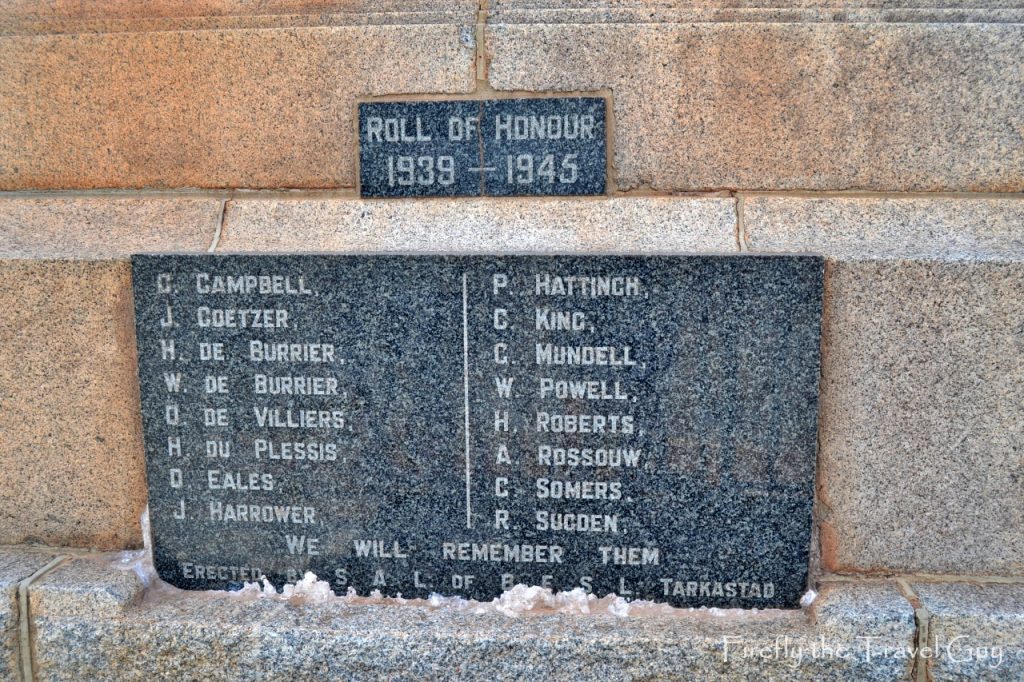
- John Jacobus Coetzer was born 30 March 1918 and was the son of Mr. and Mrs. J. F. D. Coetzer, of Tarkastad. He served with No. 1 Squadron, South African Air Force. He was killed when he was shot down by anti-aircraft fire on February 21st, 1941 as Lieutenant near Masawa, Eritrea, with his Hawker Hurricane Mk I “V7658”. He achieved a total of 2 air victories, 1 shared victory, destroyed two planes on the ground himself and shared in the destroy of 15 others on the ground. He received the Distinguished Flying Cross (DFC). He’s buried in the Commonwealth War Cemetery Asmara.
- William Derrick Eales was born on 30 January 1923 in Tarkastad. During World War 2, he was a Private in the 6th Mounted Regiment, before joining the 10th Armoured Car Company of the South African Tank Corps. He was accidentally killed on the 24th of December 1941 at the age of 18. He is buried in the Tarkastad Cemetery.
- John Ernest “Jack” Harrower was born in Port Elizabeth on 15 March 1908, before moving to Tarkastad and marrying Stella Louise Mary. He became a farmer and had 2 children. He joined the army and became a Lance Corporal of Die Middelandse Regiment. He died of natural causes at the Premier Mine Military Hospital at the age of 32 on 12 October 1940. He is buried in Thaba Tshwane Military Cemetery.
- Phillippus Rudolf Hattingh was born in Tarkastad. He became a Shoeing Smith in the South African Veterinary Corps. He died on active service on 28 March 1942. He is buried in the Tarkastad Cemetery.
- Cecil Newton King was born on 13 November 1903 in Tarkastad. He maried Dorothy King, also from Tarkastad. He became a farmer, and a father to 2 children. he became a Lance Corporal of Die Middelandse Regiment. In the North Italian village of Carpane on 27 September 1944 the Germans executed 16 Allied soldiers captured fighting with Italian partisans in that area. Escaped with other South Africans from a nearby POW camp and joined up with local partisans to carry on fighting the Germans. They became such a thorn in the flesh of the Germans that a special operation was mounted in the Monte Grappa region to capture them. They were eventually captured and murdered by the Germans. Every year on this day since the end of the war the villagers of Carpane have held a memorial service at this spot by the side of the road where they were killed. For many years the identity of the 16 was not known and the monument was simply inscribed to “16 unknown”. It was in 2008 that their identity was uncovered by Sonia Residori, an Italian academic researcher. He was 40 at the time of his execution. He is buried in Padua War Cemetery.
- Cecil Shales Mundell became a Rifleman in the Rhodesia Regiment. He died of blackwater fever and exhaustion at the age of 40 on 29 March 1941. He is buried in Bulawayo Cemetery in Zimbabwe.
- William Frederick Powell was born in Sunnyside Pretoria, before moving to Tarkastad. He became a Lieutenant in the 1st Squadron of the South African Air Forces. He was killed in action at the age of 26 on 13 July 1942 over El Alamein when his Hawker Hurricane failed to return from a combat sortie, in which the 1st Squadron claimed five Italian CR.42 bi-planes. He has a commemorative stone in Tarkastad Cemetery.
- Hubert Hamilton Roberts was born in Tarkastad, and married Nellie Roberts from Klerksdorp. He joined the 24th Squadron of the South African Air Forces and became a Lieutenant. He was killed in action at the age of 35 on 24 October 1942 when he was shot down by flak attacking ground positions near El Alamein in his Douglas Boston Mk III #AL727. He is buried in El Alamein War Cemetery in Egypt.
- Andre de Leeuw Rossouw was born in Queenstown. He became a Lieutenant in the 1st Squadron of the South African Air Force. He was killed in action at the age of 22 on 25 June 1943 when his Supermarine Spitfire Mk IX #EN257 crashed 15 miles southwest of Pozzallo. His name is engraved on the Malta Memorial in Malta.
- Charles George Somers was born on 5 July 1899 in Pearston before moving to Tarkastad. He became a farmer and a father to one child. He became a Private in Die Middelandse Regiment. He was captured at Tobruk and remained a Prisoner of War until his release in May 1945. He returned to South African and was demobilised. He died after discharge at the age of 48 on 23 October 1947. He is buried in Tarkastad Cemetery.


